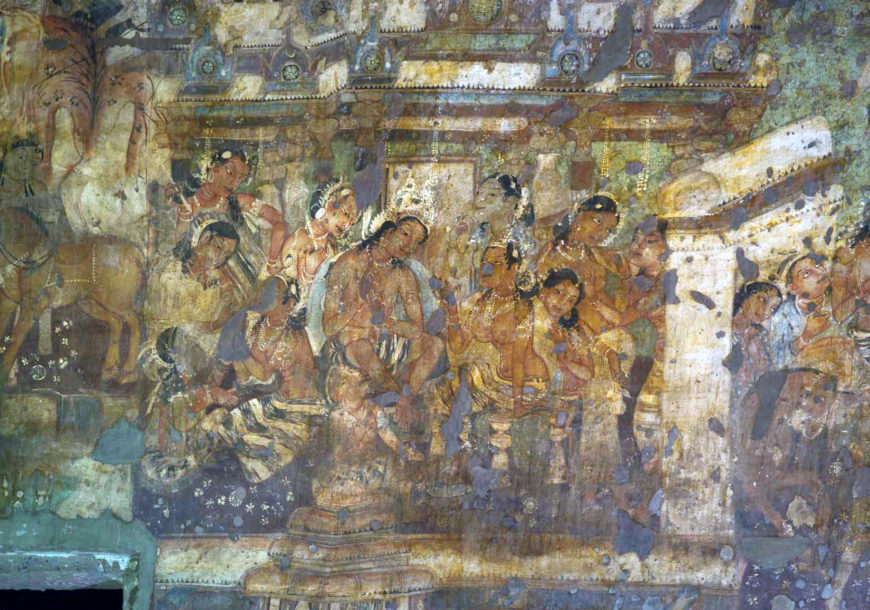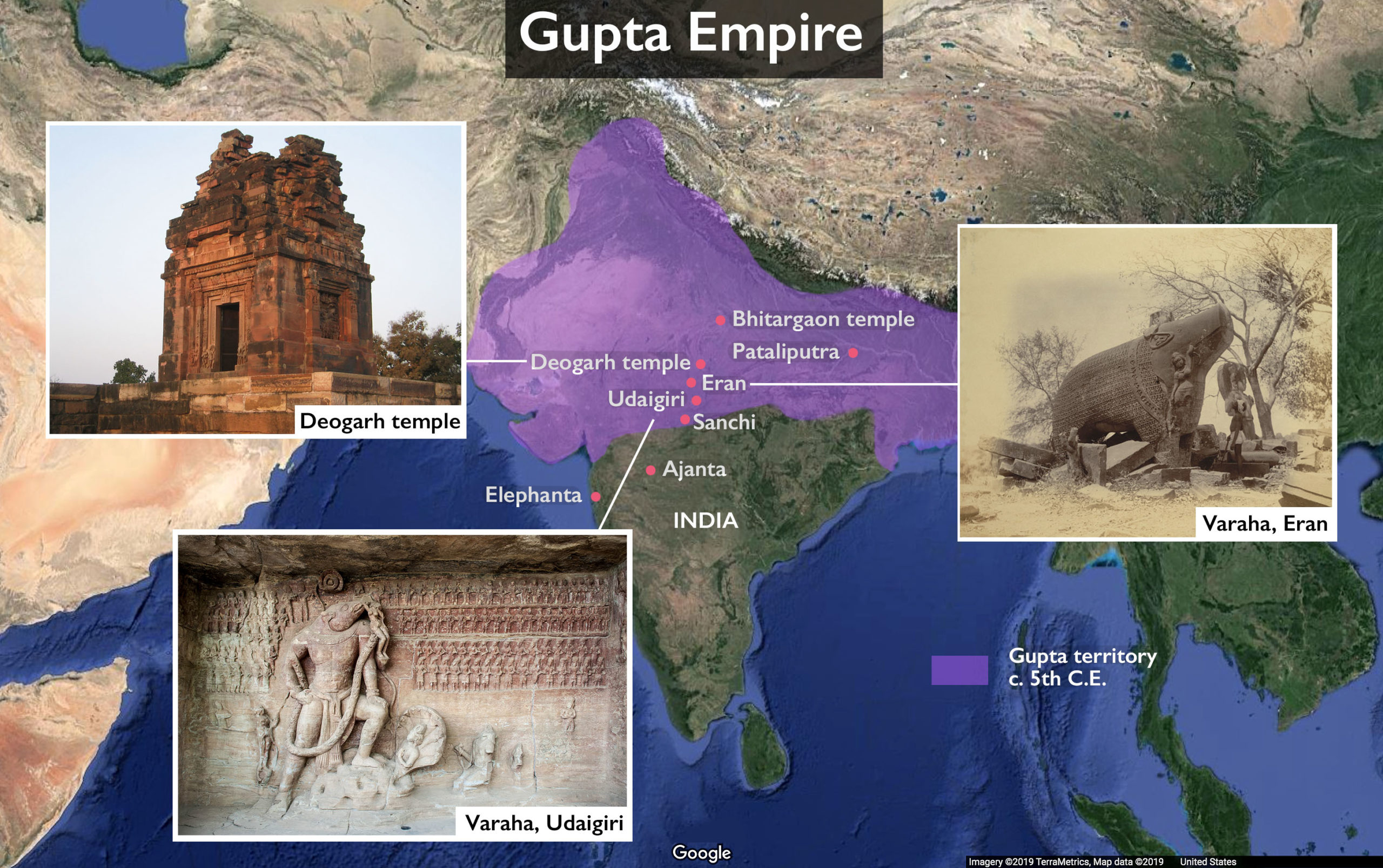
Approximate extent of the Gupta Empire, c. 5th century C.E. (adapted from Woudloper, CC BY-SA 4.0)
During the Gupta period (c. 320 – 647 C.E., named for the Gupta dynasty) there were tremendous advances in poetry, prose, and drama as well as important discoveries in mathematics and astronomy. This was the age of some of the most celebrated creatives in Indian history, including the fifth century writer Kālidāsa whose works would influence generations of writers. This was also the period in which the fifth century astronomer Aryabhata theorized that the earth rotated on its own axis and calculated the solar year at 365.3586805 days.
The Puranas, a compendium of religious literature considered sacred to both the Hindu and Jain religious traditions and consisting of stories and the genealogies of the gods, folk tales, and traditional lore, grew in prominence during the Gupta years. While it is difficult to date the Puranas because they contain anonymous texts compiled over many centuries both before and after the Gupta period, we know that Puranic stories were a popular religious and cultural reference during the Gupta years from the depiction of Puranic episodes in art and architecture. Kālidāsa’s poetry and plays also frequently engaged with episodes from the Puranas.
The Guptas were ambitious rulers and by the end of the fourth century claimed dominance over a vast swathe of northern India (see map above). They maintained a capital at Pataliputra, the same ancient center used by the formidable, and earlier, Mauryan empire (4th – 2nd century B.C.E.) and that of the emperor Ashoka Maurya (3rd century B.C.E.).
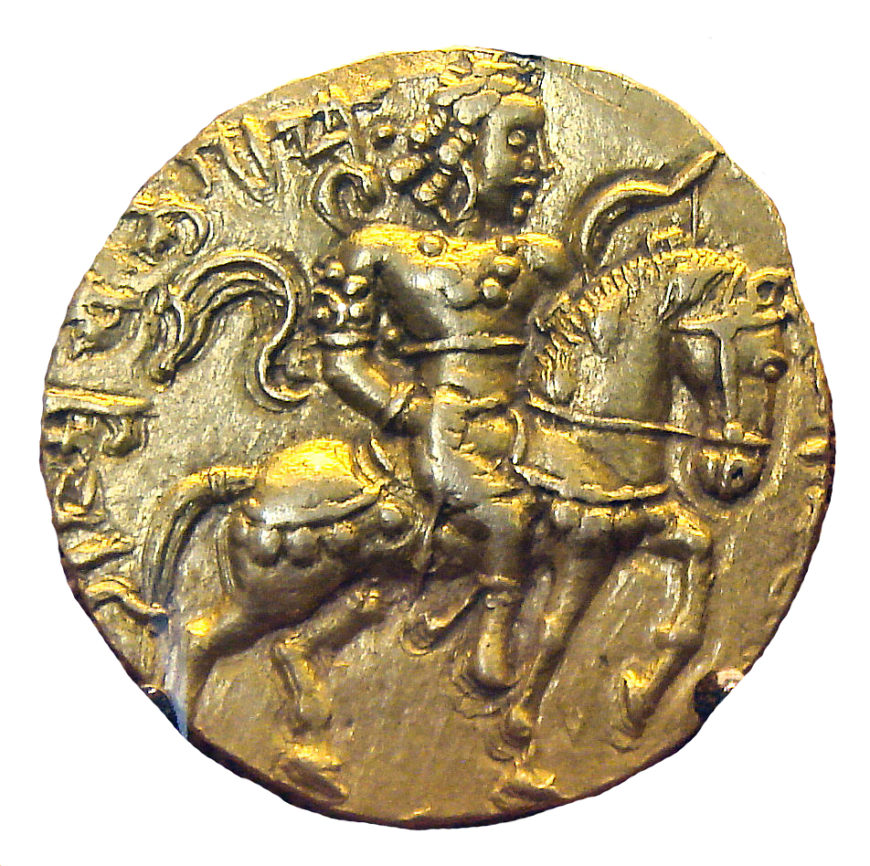
Emperor Chandragupta II on his horse, c. 380 – 415 C.E., gold coin (The British Museum)
The gold coin above shows Chandragupta II — one of the earliest and most successful Gupta rulers — who reigned from c. 380 C.E. to 415 C.E. Chandragupta is regally dressed, as is his horse, and he holds a bow as his sash flies behind him. This type of iconography emphasizes the emperor’s identification as a conqueror and the inclusion of a goddess (on the reverse side of this coin, not shown) implies divinely mandated rule. Fa Hsien, a Buddhist pilgrim from China, who was in India during the reign of this king wrote with admiration about the prosperity of the empire, describing it as a charitable place with hospitals, rest-houses, and medicine for those in need.
The Golden Age of Indian Culture?
Although Gupta overlordship was significant throughout the empire in the early years and later, local rulers were allowed a fair bit of autonomy in their territories. It is important therefore to not conflate the innovations and achievements of the Gupta period with the Guptas, and to acknowledge the contributions of regional dynasties. This is particularly important when works of art and architecture dated to the Gupta period are missing contextual information. Rather than assigning the Gupta dynastic label to these works of art and architecture, art historians use methods of connoisseurship to understand the artists, patrons, and provenance of these works. In the process, we are able to better understand the artistic developments of the period as a whole.
The Gupta period was termed the “Golden Age of Indian Culture” by some early observers who assigned the vast quantity and sophisticated quality of art from that period to the sponsorship of the Guptas. The term “Golden Age” was based on the desire of these writers for an ideal or classical style of art (using the art of ancient Greece as an example), and the opinion that art after the Gupta period was less classical and too decadent to be tasteful. The artistic developments of regional kingdoms in the Gupta era problematizes this Eurocentric perspective. The fifth and sixth century rock-cut temples at Ajanta and Elephanta, in the domain of the Vakataka and Kalachuri rulers respectively, are prominent sites that point to a richer and more complex art history of the Gupta period.
That is not to say that the Gupta rulers themselves were not important patrons of art and architecture. The Udaigiri complex of rock-cut caves in Madhya Pradesh (a large state in central India) is a an exceptional site with inscriptions that indicate sponsorship from the Gupta court. Nineteen of the site’s twenty caves are dedicated to Hindu gods and date to the fourth and fifth centuries; one cave is dedicated to the Jain religion and is dated to the early fifth century.
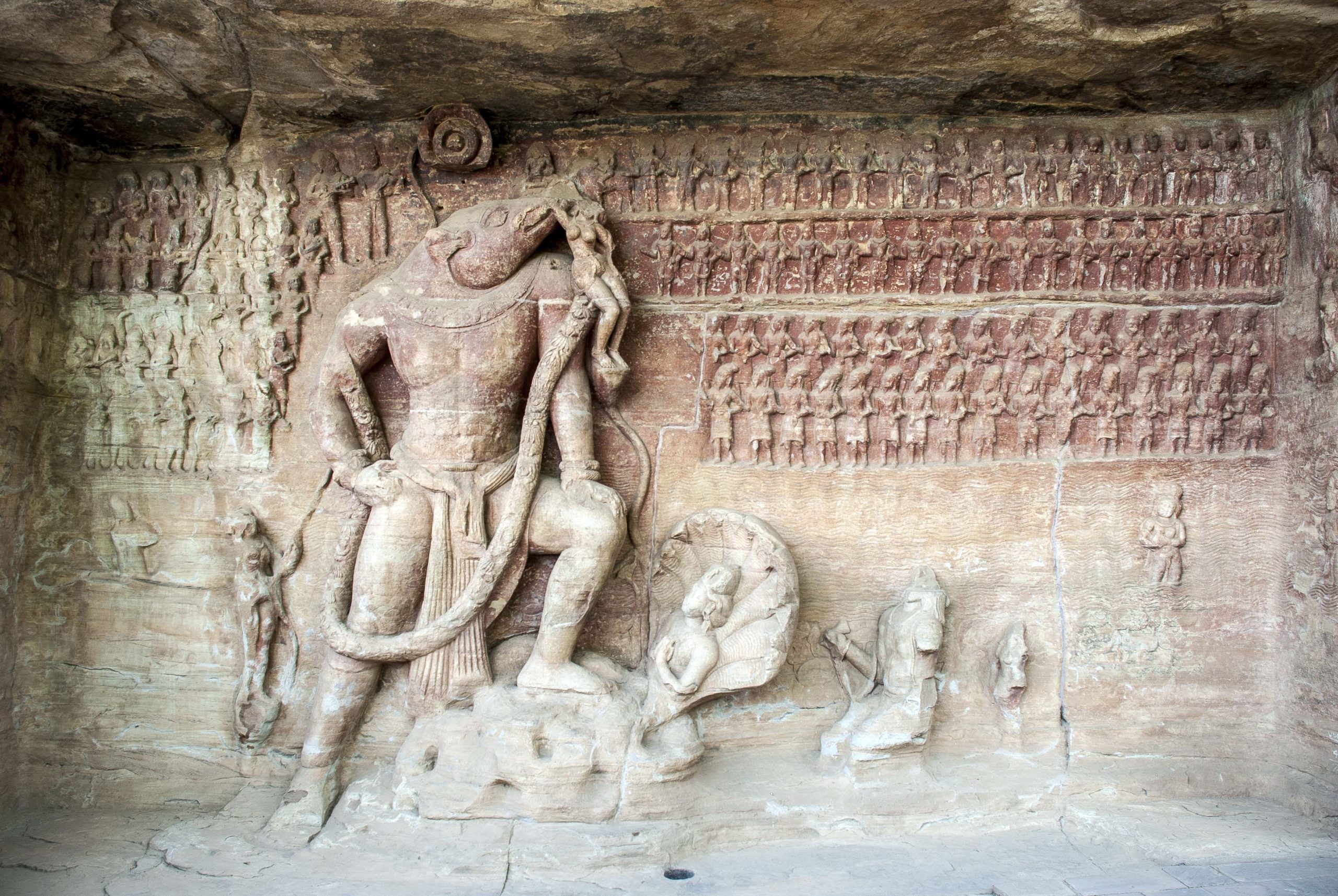
Varaha panel, cave number 5, 5th century C.E., Udaigiri rock-cut caves, Madhya Pradesh (photo: Asitjain, CC BY-SA 3.0)
Varaha, the man-boar avatar
A sculptural panel at Udaigiri (in cave number 5) depicts the Hindu god Vishnu in his man-boar form avatar known as Varaha. The panel shows Varaha rescuing Bhudevi (goddess of earth) from a cosmic flood, a story that is recounted frequently in Hindu religious literature, including the Puranas. Varaha is shown here as a hero posing regally with the goddess as she dangles from his tusk. An audience of gods, sages, and people — most in crowds of organized rows — witness the event with awe.

Varaha, 5th century CE, Eran, Madhya Pradesh (photo: ArnoldBetten, public domain)
Scholars have suggested that the Guptas may have been especially attached to the Varaha avatar of Vishnu. A remarkable sculpture — this time showing the Varaha avatar in the form of a boar (not a man-boar as at Udaigiri cave number 5) — is found in Eran, another site in Madhya Pradesh. Eran has a number of temples dated to the Gupta period and its association with the Guptas is well-established by way of inscriptions.
Eran’s Varaha is colossal – nearly twelve feet in height – and is shown again with the goddess holding on to his tusk. The artists cleverly included the witnesses of the miracle on Varaha’s body itself which is covered almost entirely by rows of spectators. Additional figures are also carved on his ears and snout.
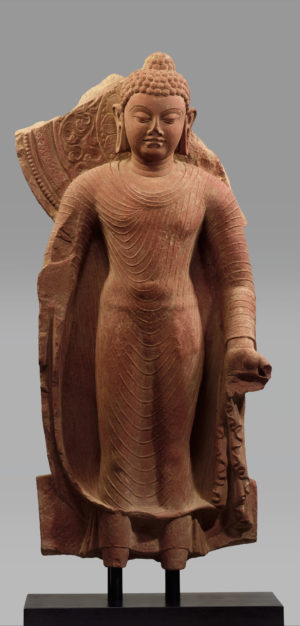
Standing Buddha Offering Protection, late 5th century, red sandstone, Mathura (The Metropolitan Museum of Art)
The Gupta Buddha
The aniconic tradition of representing the Buddha was abandoned by this stage in favor of depictions of the deified Buddha and the Gupta period boasts some of the most impressive examples. Scholars have suggested that the style of the Gupta Buddha evolved out of the Gandhara and Mathura style of Buddhas. The Gandhara and Mathura Buddhas were distinct versions of the Buddha image developed during the Kushan empire (2nd century B.C.E. – 3rd century C.E.) in the Gandhara and Mathura regions respectively. Kushan-ruled territories became part of the Gupta empire and it is certainly possible that the aesthetic style of Buddha images produced in those areas inspired the development of the Gupta Buddha.
The process by which the amalgamation of features from both the Gandhara and Mathura styles led to the Gupta image was surely a complex and involved process that developed over centuries. In addition, while Gupta period artists appear to have inherited the developments of the Kushan empire in many aspects, they likely also gained from the developments of art produced in other regions and kingdoms — both previous and contemporaneous. It is helpful to also remember that artists and therefore styles of art may have been itinerant at various points in history.
Gupta period Buddhas are characterized by covered shoulders, a head full of tight curls that cover even the ushnisha, and ornately carved halos. Images of the Jina (the 24 great teachers and perfected beings of the Jain religion) from this period are closely similar to Buddha images, especially in the rendering of a head of tight curls. The Jina’s posture and adornment follows the iconographic prescriptions of Jain sacred imagery and emphasize immobility and austerity.
“Gupta” as a style
While using the Gupta dynastic label to categorize all art produced in the Gupta period is, as we have seen above, problematic, there are certain developments in style and iconography from the Gupta period that are important to note, such as the tendency to render deities as life-sized or larger and the consistent use of hierarchic scaling. See the Varaha panel at Udaigiri above, for example.
Workshops in the Gupta period also employed signature styles. Images of the Buddha from the Mathura region, for instance, were produced in mottled red sandstone. The Mathura workshops also preferred to render the folds of the Buddha’s robes as looped strings as opposed to the thick folds preferred by Gandharan workshops in the Kushan period. Buddha images from the region of Sarnath, on the other hand, were made from a yellowish-tan sandstone and are shown wearing smooth robes.
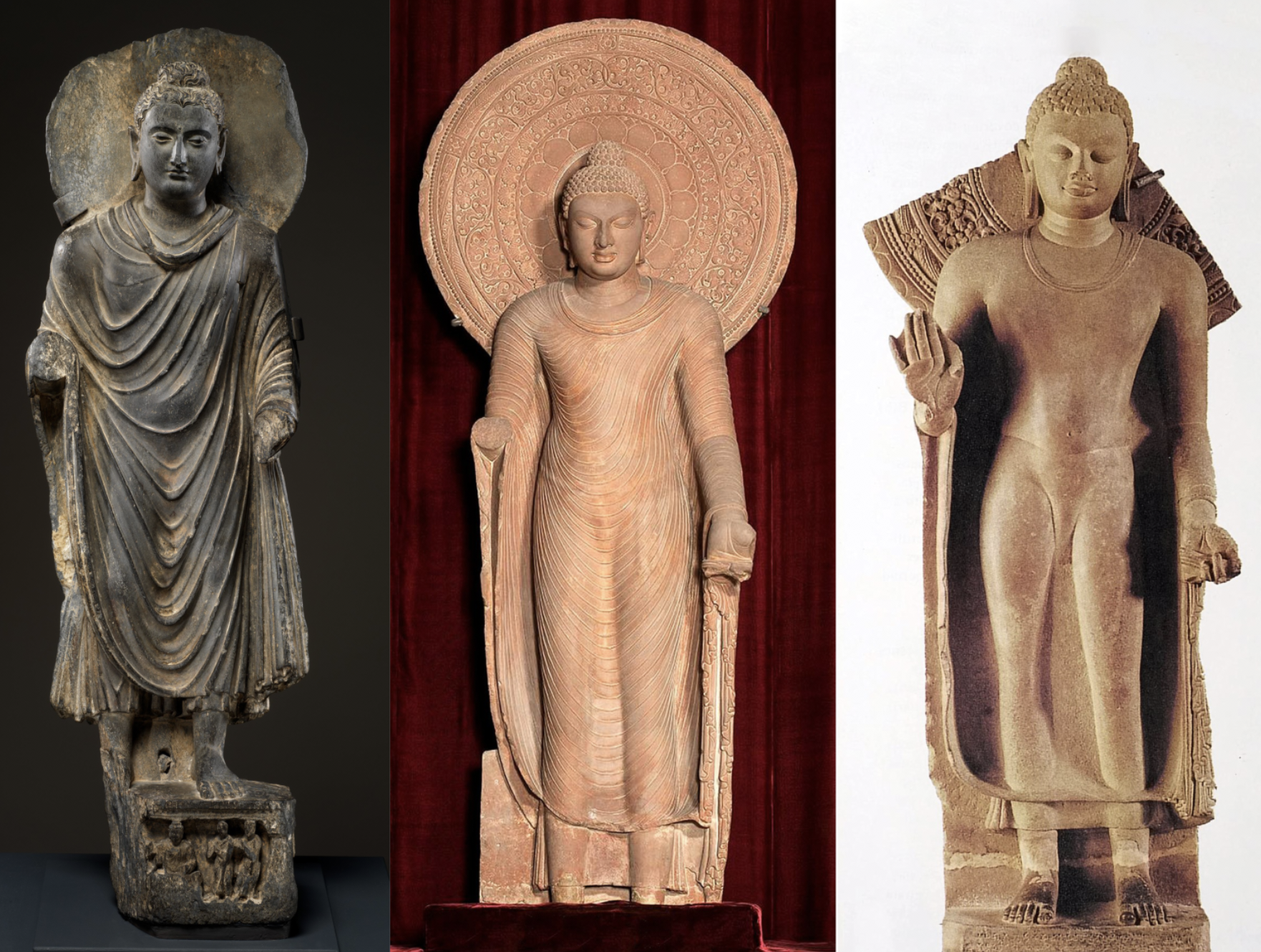
Left to right: Buddha, 3rd century CE, schist, Gandhara (The Metropolitan Museum of Art); Standing Buddha, c. 5th century CE, red sandstone, Mathura (Rashtrapati Bhavan Presidential Palace, New Delhi); Standing Buddha, 474 CE, sandstone, Sarnath (Sarnath Museum)
Scholars believe that portable Gupta period Buddhas, carried by pilgrims back to their homelands, played a role in the development of the Buddha image in the art of East and Southeast Asia. The Gupta Buddha would also influence later images of the Buddha in South Asia — such as those that were produced in the territory of the Pala dynasty (c. 700 – 1200) in eastern India. The Pala period saw the Buddha image develop even further and is notable for its inclusion of ornate crowns.
Gupta period sculpture and painting
In addition to its prolific production of Buddha images, the Gupta period is also known for its Hindu and Jain sacred imagery fashioned from terracotta, stone, and metal. Surviving terracotta examples include sculptural plaques that were meant to adorn the walls of temples.
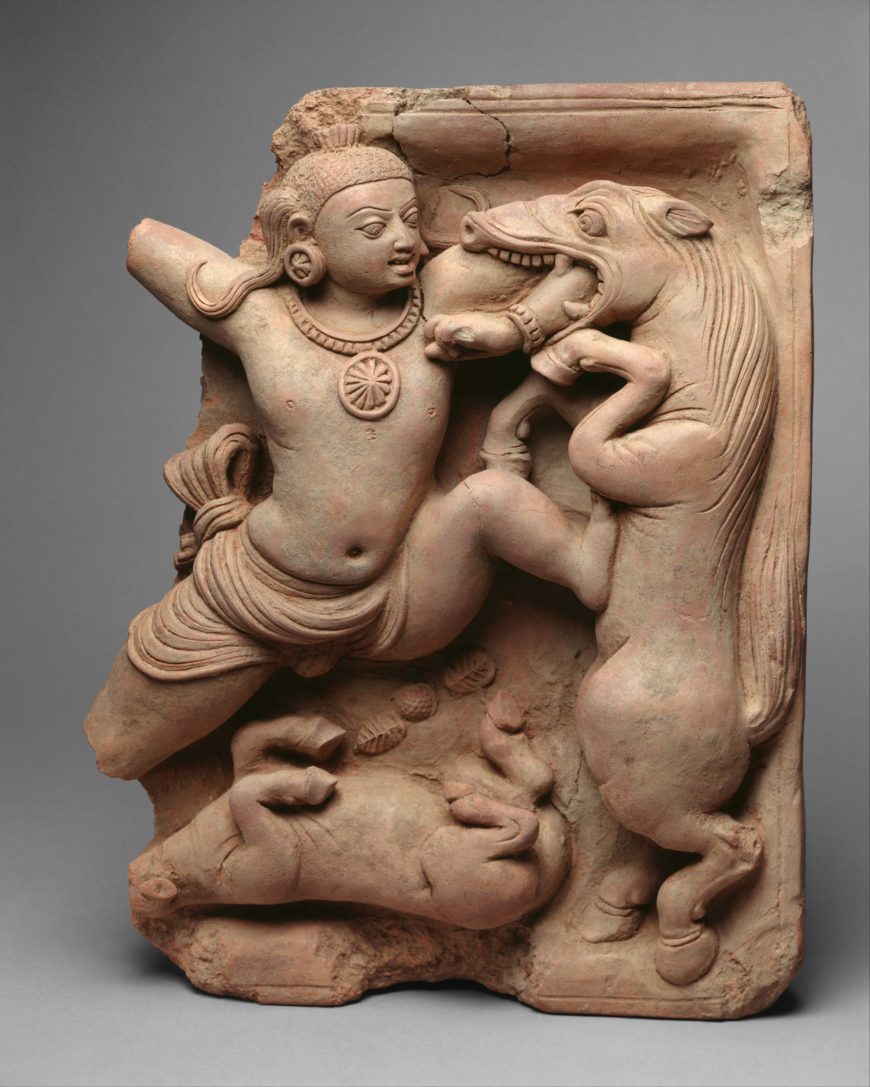
Krishna Killing the Horse Demon Keshi, 5th century, terracotta (The Metropolitan Museum of Art)
The terracotta panel above shows the Hindu god Krishna (also an avatar of Vishnu) killing the horse demon Keshi. Krishna pushes the horse-demon back with his leg and sticks his elbow in Keshi’s mouth to stop the demon’s advance. If there is any doubt as to the aftermath of this encounter, the dead Keshi lies at the bottom of the panel.
Painting too was likely a popular art-form in the Gupta period, although sadly, few examples have survived. If the mural paintings at the Buddhist rock-cut caves of Ajanta are any indication, painting techniques by the fifth century were highly developed. Ajanta’s paintings are also priceless for the clues that they contain on the artistic achievements of the period; we only need look at the accessories and clothes worn by the protagonists of the murals as well as at the architectural spaces that they occupy to better know the style of jewelry, textiles, and secular architecture that was popular at that time.
Temple architecture
Most Gupta-period architecture that survives in-situ is religious in nature and is built from stone and brick. A modest temple structure known as number 17 at the sacred complex at Sanchi – famous for its great stupa, and believed to date to the early fifth century, gives an idea of the early style of Indian temple architecture.
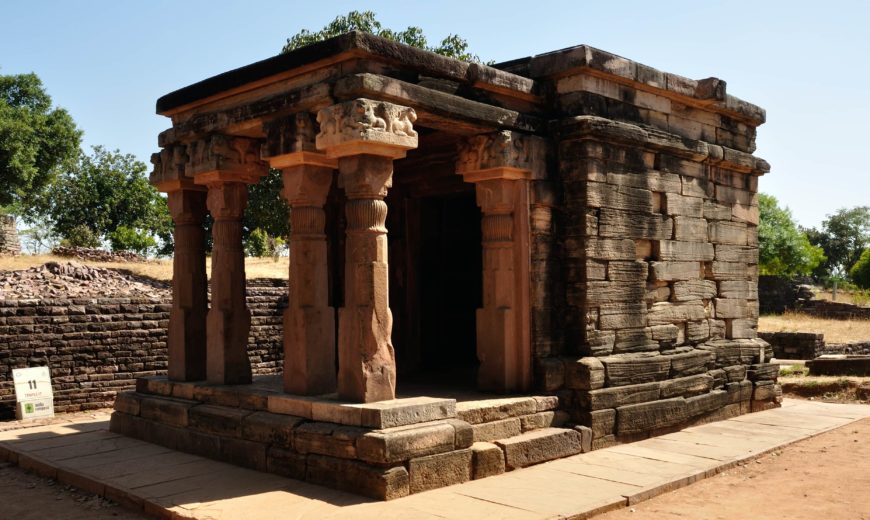
Temple number 17, Sanchi (photo: Biswarup Ganguly, CC BY 3.0)
Temple number 17 is flat-roofed, mostly unadorned, and has an attached portico marked by four pillars topped with lion capitals. The temple is quite different from another fifth century brick-temple at Bhitargaon that sits at the center of a square plan and would have once had an impressive shikara (pyramidal roof). Although the temple is heavily reconstructed today, it still preserves some of its sculptured terracotta panels, providing a glimpse of its original grandeur.
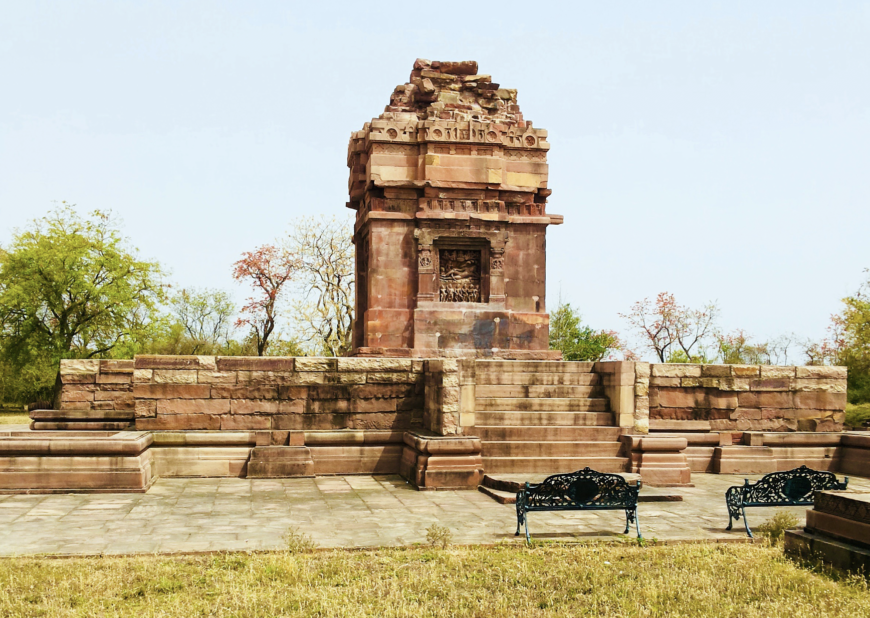
Dashavatara Temple, 6th century C.E., Deogarh (photo: Work2win, CC BY-SA 4.0)
Another Gupta period temple, the sixth century Dasavatara temple at Deogarh (above), also sits at the center of a plinth (an architectural feature that becomes increasingly common in temple building). Like Bhitargaon, Deogarh features sculptured panels, although here, three large niches containing sacred imagery associated with the god Vishnu receive special prominence — each one featured on its own wall. The panels may have originally been located within an ambulatory that is now missing.
By the end of the sixth-century, hastened by military incursions and the loss of territories, the Gupta empire fell into decline. Nevertheless, the Gupta period’s formative developments in art, architecture, and religious iconography would have a lasting impact on the art and architecture of South and Southeast Asia.
References:
Frederick Asher, “Historical and Political Allegory in Gupta Art.” In Essays on Gupta Culture, ed. Bardwell Smith (Delhi: Motilal Banarsidass, 1983), pp. 55 – 57.
Catherine Becker, “Not your average boar: the colossal varaha at Eran, an iconographic innovation,” Artibus Asiae 70, no. 1, “To My Mind”: Studies in South Asian Art History in Honor of Joanna Gottfried Williams. Part II (2010): 123 – 149.
Vidya Dehejia, Indian Art (London: Phaidon Press, 1997).
Wendy Doniger, The Hindus: an Alternative History (Oxford: Oxford University Press, 2010).
Partha Mitter, Indian Art (Oxford: Oxford University Press, 2001).
Ju-Hyung Rhi, “From Bodhisattva to Buddha: the Beginning of Iconic Representation in Buddhist Art,” Artibus Asiae 54, no. 3 / 4 (1994): 207 – 225.
Bardwell L. Smith, Essays on Gupta Culture (Columbia: South Asia Books, 1983).
Additional resources
A record of Buddhistic Kingdoms by Fa-Hsien

